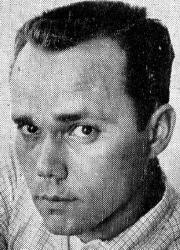 |
Tear Gas and Hungry Dogs
Midwood Tower, New York, 1963 dedication: to Jane... The blurb on the back:
THE SIGHT AND SOUND AND SMELL OF HATRED
ABOUT THE AUTHOR: William Sloan has worked as a newspaper reporter-editor since graduating from North Texas State University in 1957. He is now an editor for the Dallas Times Herald. Mr Sloan writes with honesty and compassion about a subject he knows at first hand; and he manages to show both sides of the racial coin fairly in this, his first novel.
That's the clue right there, in the note about the author: 'he manages to show both sides of the racial coin fairly'. Fairly? I'm sorry but this is not a subject that requires fairness. We're talking about a novel in which the Freedom Riders of the Civil Rights movement turn up in a sleepy, racist town down South, and provide a focus for the racial conflict that lies latent in such a society. And fairness isn't relevant. Apartheid practices in the Southern States of the US was a clear-cut moral issue, on which one took sides - there was good and there was evil. To treat the two sides with fairness is a fraud - in a situation of inequality, the application of equal treatment is bound to favour those in power. So you won't be surprised to find that the white assistant district attorney is the real focus of our sympathies. The real problem with the book, though, is not so much its political failings as the fact that it's so damn schematic in construction. There's the angry young black activist contrasted with the cautious old black man, then there's the liberal young white man contrasted with the reactionary old white man, and so on and so forth. It's all too much like the cats that would be assembled for a TV documentary on a 'controversial' subject - the kind of show where no conclusions are reached and nothing is achieved. And certainly it's not the way to construct a novel. However, as a piece of history, a book that captures an attitude of a turbulent period, it has a certain curiosity value. This William Sloan, incidentally, is not the same man as the one who wrote To Walk The Night and The Edge of Running Water. ENTERTAINMENT VALUE: 2/5 HIPNESS QUOTIENT: 4/5  a gallery of civil rights books home |

